- Comics
- Comics Reviews
- Manga
- Comics Reviews
- European Comics
- News
- Comics News
- Press Releases
- Columns
- Spotlight
- Digital Comics
- Webcomics
- Cult Favorite
- Back Issues
- Webcomics
- Movies
- Toys
- Store
- More
- About
By Eli Green
October 11, 2006 - 13:00
The
original Mario vs. Donkey Kong, for Game Boy Advance, had Mario
retrieving all of the Mini Mario toys which Donkey Kong had stolen.
This time Donkey Kong has his eye on a slightly larger prize.
Pauline, the damsel in distress from the original Donkey Kong is
back, and kidnapped again.
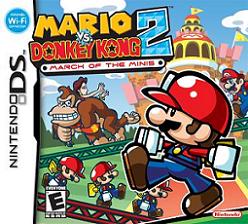
People love the Mini Mario toys so much that the Mario Toy Company has expanded its line to include Mini Donkey Kong, Mini Toad and Mini Peach figures. The toy line becomes so successful that Mario is able to fulfill his dream of opening a theme park, called Super Mini Mario World, based around the popular miniature toys. Today is opening day for the park and there is a large crowd, including Donkey Kong and, special guest, Pauline. At the ribbon cutting ceremony, DK sees Pauline and immediately falls in love with her, once again. Rushing to her side, DK tries to give Pauline one of his Mini Donkey Kong toys at the same time Mario is handing her one of his. Pauline chooses the Mini Mario and, in a fiery rage, DK grabs her, runs for the elevator and heads to the roof of the theme park. From that point on Mario must use the Mini Marios to get from room to room, floor to floor, defeat Donkey Kong and rescue Pauline.
It's not a great story, but it's a great way to start the game a rekindle that love for the style of the original Donkey Kong game. Players will find themselves trying to make their way through nine rooms on each of the eight floors (a total of 72 rooms) of Super Mini Mario World, guiding the Mini Marios in order to collect them for each floor's boss stage. Each floor of Super Mini Mario World will have a different Mario based theme. The total of Mini Marios collected on each floor is the number that players will be able to use when fighting DK in the boss stages.
Gameplay
The
gameplay mechanics in Mario vs. Donkey Kong 2 are, simply put,
simple. Using the stylus to do all the work, with the exception of
using the buttons to control where map view, the Mini Marios are
controlled with simple swiping and pointing gestures. To move a Mini
Mario, swipe the stylus over that Mini Mario in the desired direction
and it will come to life and start marching forward. To make a Mini
Mario jump, swipe the stylus up, to make it drop down from something
it is holding on to, swipe the stylus down, and to stop it in its
tracks, simply tap the Mini Mario and it will stop, not that you'll
want to be doing that. It's a great, and unique, control system, and
its simplicity means anyone can pick it up and play. The only problem
that occurred when I was trying to control the Mini Marios was that
some of my swipes on the touch screen were misinterpreted by the
game. Sometimes I would swipe the stylus to make a Mini Mario turn
around, and it would stop instead. Though it didn't happen
frequently, it sometimes caused me to have to repeat an entire room
over, which, as fun as they were, got annoying after the fifteenth
try (in really difficult rooms).
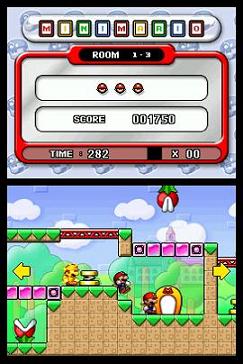
Each
room will have a different number of Mini Marios to collect. Some
will have only two, while some rooms will have up to eight. The more
Mini Marios a player collects in a room, the higher their score will
be at the end of the room, resulting in a bronze, silver or gold
star. If the score isn't high enough, a player won't even receive a
bronze star. The way to get the highest score in each room is to get
collect all of the Mini Marios in a room, have them exit the room in
a perfect
chain and, if possible, have them moving nonstop from the
time they are activated. If one Mini Mario is not activated while
another one is, it will not affect
the nonstop score meter. One of
the most frustrating things at the end of a room is to have gotten
that perfect chain with all of the Mini Marios in the room, only to
find out that you didn't keep them going nonstop. The most difficult
part of controlling the Mini Marios is trying to control a large
number of them at the same time. Keeping them going isn't a problem,
as they continue walking until they are stopped, but trying to get
them all where you want to go while one is walking towards something
blocking its path and others are quickly marching to their deaths at
the hands of a huge drop is no cake walk.
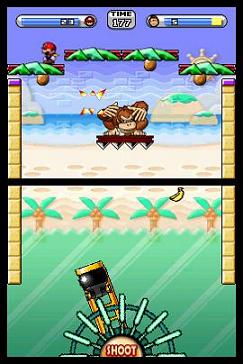
The boss stages are also very unique, both in their layout and their control system. Every boss stage has the Mini Marios battling Donkey Kong in a room that follows the theme of the floor, like dropping coconuts on DK's head on the Tropical Forest floor, or trying to guess which pipe DK will come out of while trying to dodge fireballs being spat out by Piranha Plants. To fight DK in the boss stages, players shoot the Mini Marios out of a cannon in order to hit DK or cause something to land on DK's head. Depending on the floor, the cannon will either be on a track, which makes the cannon strafe left and right and only allows the Mini Marios to be shot forward, or on a turning post, which makes the cannon arc to either the left or right and allows the Mini Marios to be shot at angles.
Every floor has collectibles, which allow extras to be unlocked. Collecting silver and gold stars will open up special levels, while collecting all of the Mario cards on a floor will open up the Shy Guy Smash mini game for that specific floor. Shy Guy Smash is a lot of fun, and definitely worth the extra time, trying to get those cards. Another great feature in the game is the ability to make new maps to play. The maps can be based on templates, or players can use their imagination and come up with all kinds of different designs. There are a lot of level design kits to collect, including three special kits. Players can also load their maps up to Nintendo Wi-Fi Connection and find maps made by other players, which really extends the amount of play time for the game.
Environment and Graphics
While
there isn't much to talk about in the way of environment in Mario vs.
Donkey Kong 2, it's important to note that the development team did a
good job of working the themes into each floor of the game. Each
floor in the game has its own specific theme, and the way the rooms
look fit well with each floor's theme. Even the objects on each floor
have different designs which you won't find on other floors.
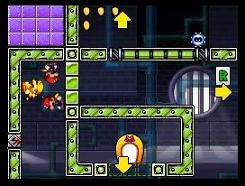
The graphics in the game are 2-D cartoon styled. Everything works in a regular side-scrolling style, except for the cutscenes, which are in full 3-D. All of the models are well drawn and fully stylized, whether it's the Mini Marios or enemy toys like the Mini Donkey Kong which throws Mini Marios in the air or the Piranha Plants. The only character which didn't quite seem to look like I expected was Donkey Kong. For some reason, the area where his eyes are normally visible didn't quite look right. Most of Donkey Kong was drawn well, but that part bothered me a bit. If you look on the case cover or any place other than during the gameplay itself, DK's eyes are their normal white, with black dots. For some reason, during the gameplay, the entire white area of DK's eyes was the same colour as his face.
Sound
The
sound design in Mario vs. Donkey Kong 2 is very nicely done. The
sound effects were a nice piece that fit in well with the game, but
the music was great, and clearly had a lot of work put into it. The
sounds in the game, from the
cranking of the Mini Marios to the very
identifiable sound of Piranha Plants
spitting fireballs, were nothing
special, but definitely
essential to the game. If any of the sounds
had been replaced by something else, they might not have quite fit as
well as they did. In particular, the sound of a Mini Mario smashing
apart after a hard fall versus the sound of a Mini Mario being
deactivated because it walked into something, like a Shy Guy, were
quite different. If they were reversed it wouldn't quite sound right.
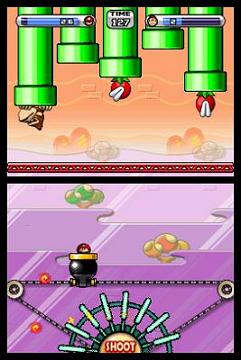
The
music differed floor by floor, changing for each theme, and even for
the battles against Donkey Kong. The music in some levels seemed very
familiar, while, in others, had a whole new feel. The music that felt
particularly familiar was on the Toadstool Castle floor (it was a mix
of the Mario theme). In the audio settings I was able to find over 70
different types of music and more than 140 different sound effects.
One of the biggest surprises in the audio options for this game was the surround sound option. The game uses the stereo speakers to create a virtual surround experience. I tried using the surround setting, but found no noticeable difference between it and stereo, which was a bit disappointing. The development team shouldn't have put the option in if they weren't going to fully utilize it.
Conclusion
Mario vs. Donkey Kong 2: March of the Minis is a great game for anybody to play. It's very easy to pick up and allows for hours of play, whether it's through the regular game, mini games, or just through player made levels. The graphics are nicely stylized and it sounds great, and there are plenty of extra things to toy around with that will keep you coming back for more.
Gameplay:
8.5
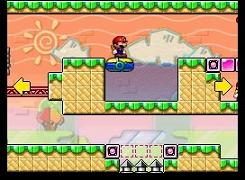
Environment and Graphics: 8.5
Sound: 9
Story: 6.5
Fun: 9
Verdict: Buy It